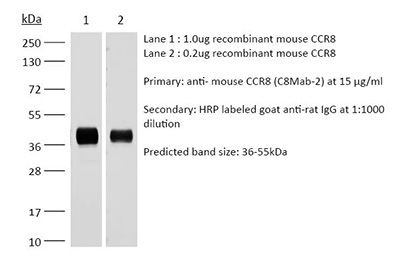InVivoMAb anti-mouse CCR8 (CDw198)
Product Description
Specifications
| Isotype | Rat IgG2b, κ |
|---|---|
| Recommended Isotype Control(s) | InVivoMAb rat IgG2b isotype control, anti-keyhole limpet hemocyanin |
| Recommended Dilution Buffer | InVivoPure pH 7.0 Dilution Buffer |
| Immunogen | mCCR8 expressing CHO cells |
| Reported Applications |
Flow cytometry Western blotting Immunofluorescence For details on in vivo applications, please contact technicalservice@bioxcell.com |
| Formulation |
PBS, pH 7.0 Contains no stabilizers or preservatives |
| Endotoxin |
≤1EU/mg (≤0.001EU/μg) Determined by LAL assay |
| Purity |
≥95% Determined by SDS-PAGE |
| Sterility | 0.2 µm filtration |
| Production | Purified from cell culture supernatant in an animal-free facility |
| Purification | Protein G |
| Molecular Weight | 150 kDa |
| Storage | The antibody solution should be stored at the stock concentration at 4°C. Do not freeze. |
| Need a Custom Formulation? | See All Antibody Customization Options |
Application References
Flow Cytometry
Tanaka T, Nanamiya R, Takei J, Nakamura T, Yanaka M, Hosono H, Sano M, Asano T, Kaneko MK, Kato Y (2021). "Development of Anti-Mouse CC Chemokine Receptor 8 Monoclonal Antibodies for Flow Cytometry" Monoclon Antib Immunodiagn Immunother 40(2):65-70.
PubMed
CC chemokine receptor 8 (CCR8) belongs to the class A of G protein-coupled receptor. It is highly expressed on Treg and T helper 2 (TH2) cells recruited to the inflammation site and is implicated in allergy and asthma. Recently, CCR8+Treg cells have been suggested to be a master regulator in the immunosuppressive tumor microenvironment; therefore, developing sensitive monoclonal antibodies (mAbs) for CCR8 has been desired. This study established a specific and sensitive mAb for mouse CCR8 (mCCR8), which is useful for flow cytometry by using the Cell-Based Immunization and Screening (CBIS) method. The established anti-mCCR8 mAb, C8Mab-2 (rat IgG2b, kappa), reacted with mCCR8-overexpressed Chinese hamster ovary-K1 (CHO/mCCR8) cells and P388 (mouse lymphoid neoplasma) or J774-1 (mouse macrophage-like) cells, which express endogenous mCCR8 by flow cytometry. C8Mab-2, which was established by the CBIS method, could be useful for elucidating the mCCR8-related biological response by flow cytometry.
Immunofluorescence
Saito M, Tanaka T, Asano T, Nakamura T, Yanaka M, Handa S, Komatsu Y, Harigae Y, Tateyama N, Nanamiya R, Li G, Suzuki H, Kaneko MK, Kato Y (2022). "C8Mab-2: An Anti-Mouse C-C Motif Chemokine Receptor 8 Monoclonal Antibody for Immunocytoche
PubMed
C-C motif chemokine receptor 8 (CCR8) is a G protein-coupled receptor predominantly expressed in regulatory T (Treg) and T helper 2 cells. The evidence that CCR8 expression in Treg is increased in cancers, CCR8 increases migration activity of Treg, and CCR8 induces the anti-apoptotic activity in T cell leukemia and lymphoma suggests that CCR8 is associated with cancer development. Thus, developing a specific monoclonal antibody (mAb) for CCR8 is useful for diagnostic and therapeutic purposes and the anti-CCR8 mAb becomes a remarkable experimental tool for basic research. We previously developed an anti-mouse CCR8 (mCCR8) mAb called C8Mab-2 (rat IgG2b, kappa) that was applicable to flow cytometric analysis for both endogenous and exogenous mCCR8. This study showed that C8Mab-2 and recombinant C8Mab-2 (recC8Mab-2) were specifically bound to exogenously expressed mCCR8 in mCCR8-overexpressed Chinese hamster ovary-K1 cells. In addition, we found that C8Mab-2 and recC8Mab-2 recognized endogenous mCCR8 in P388 (a mouse lymphocyte-like cell line) and J774-1 cells (a mouse macrophage-like cell line). These data demonstrate that C8Mab-2 and recC8Mab-2 are useful for immunocytochemical analysis.
Flow Cytometry
Kobayashi H, Suzuki H, Tanaka T, Kaneko MK, Kato Y (2024). "Epitope Mapping of an Anti-Mouse CCR8 Monoclonal Antibody C8Mab-2 Using Flow Cytometry" Monoclon Antib Immunodiagn Immunother 43(4):101-107.
PubMed
The C-C motif chemokine receptor 8 (CCR8) is highly and selectively expressed in regulatory T (Treg) cells and is associated with tumor progression. The massive accumulation of Treg cells into tumors suppresses the effector function of CD8+ cells against tumor cells. Therefore, selective depletion of Treg cells using anti-CCR8 monoclonal antibodies (mAbs) reinvigorates antitumor immune responses and improves responses to cancer immunotherapy. Previously, we developed an anti-mouse CCR8 (mCCR8) mAb, C8Mab-2, using the Cell-Based Immunization and Screening method. In this study, the binding epitope of C8Mab-2 was investigated using flow cytometry. The mCCR8 extracellular domain-substituted mutant analysis showed that C8Mab-2 recognizes the N-terminal region (1-33 amino acids) of mCCR8. Next, 1×alanine (or glycine) scanning and 2×alanine (or glycine) scanning were conducted in the N-terminal region. The results revealed that the 17-DFFTAP-22 sequence is important for the recognition by C8Mab-2, and Thr20 is a central amino acid of the epitope. These results revealed the involvement of the N-terminus of mCCR8 in the recognition by C8Mab-2.

